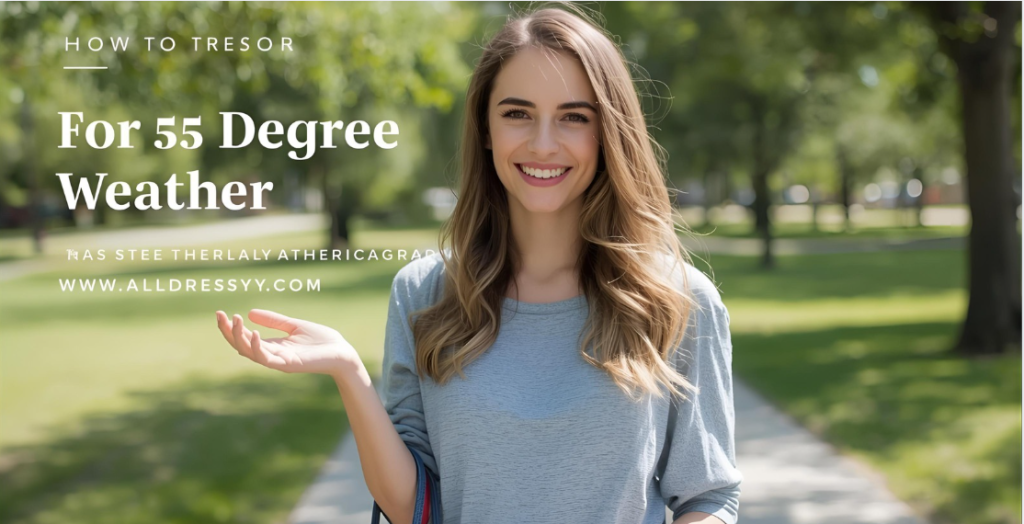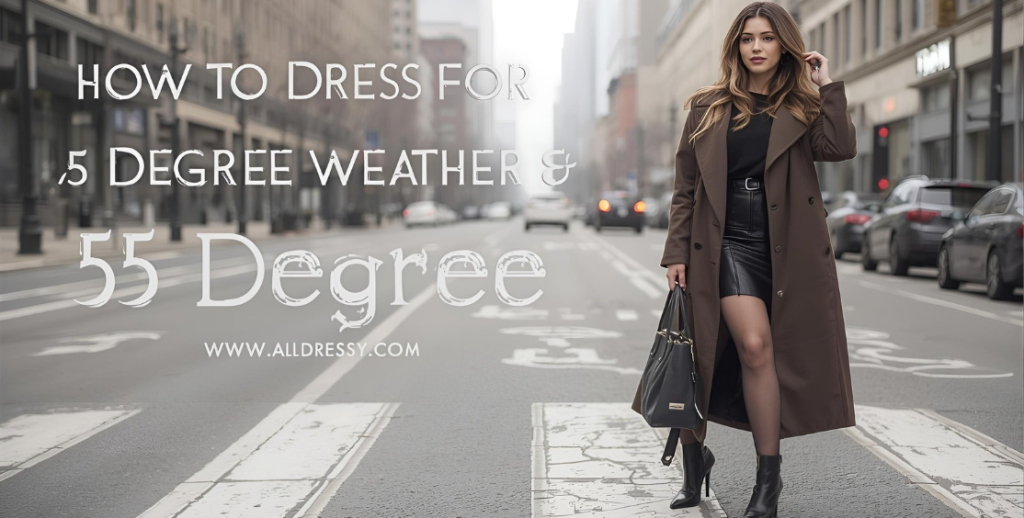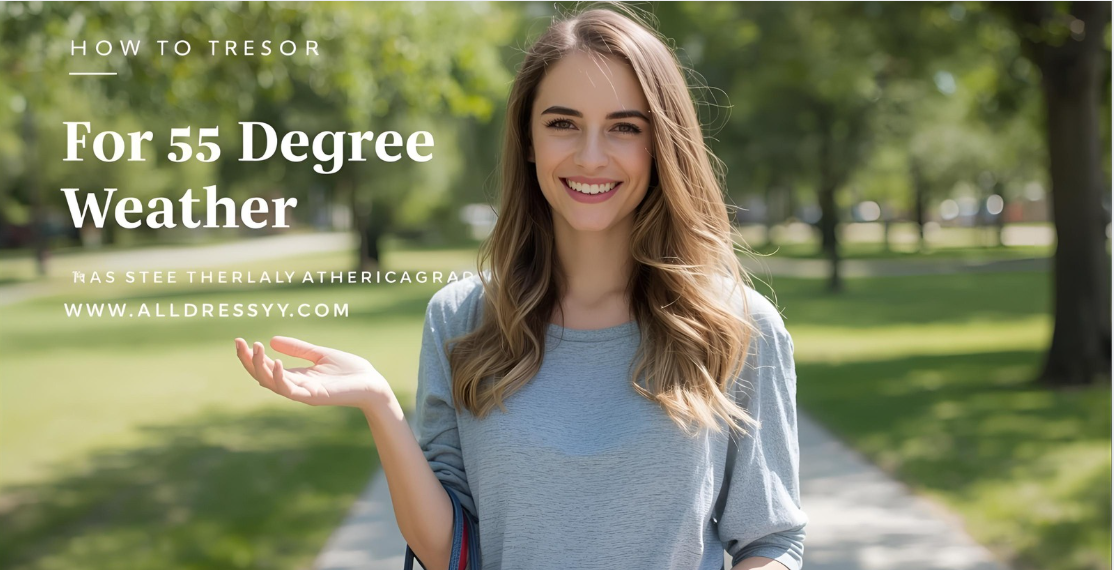How to dress for 55 degree weather is the sartorial sweet spot that many of us dream of. It’s that perfect, crisp Goldilocks zone—not too hot, not too cold, but often surprisingly tricky to get right. This temperature demands a strategic approach to your wardrobe, one that balances warmth with breathability and style with practicality. Dressing for 55°F (approximately 13°C) is less about braving the elements and more about mastering the art of layering. Whether you’re heading to the office, enjoying a weekend hike, or meeting friends for an alfresco coffee, getting your outfit right for this climate can make the difference between feeling comfortably chic or constantly adjusting your clothes. This comprehensive guide will provide you with an in-depth, actionable framework for building the perfect 55-degree wardrobe, exploring everything from fabric science and core layering principles to activity-specific outfits and accessory strategies.
Why 55 Degrees is the Perfect Temperature for Style

Before we dive into the specifics, it’s worth appreciating why 55°F is such a fantastic temperature for fashion. This climate provides the ideal canvas for showcasing your style without the limitations of extreme weather.
- The Layering Playground: You can wear multiple pieces without overheating or feeling bulky. This allows you to play with textures, colors, and silhouettes in a way that isn’t possible in summer or deep winter.
- Fabric Versatility: It’s cool enough for cozy knits and light enough for breathable cottons. You have the freedom to mix and match a wide range of materials.
- Extended Wear for Key Pieces: Your favorite jackets, light sweaters, and stylish scarves get their moment in the sun without being hidden under a heavy parka.
- Comfort Equals Confidence: When you are not shivering or sweating, you can focus on enjoying your day, which naturally boosts your confidence and overall demeanor.
The Science of Comfort: Understanding Your Body in 55-Degree Weather

To truly master how to dress for 55 degree weather, it helps to understand what’s happening to your body. At this temperature, your body is working to maintain its core temperature without the extreme stress of colder or hotter climates. The key is maintaining a comfortable microclimate around your skin. Effective layering does this by trapping body heat in small pockets of air between fabrics, acting as insulation. The goal is to create a system that can be easily adjusted as your activity level changes—whether you’re walking briskly, sitting still at a desk, or moving in and out of heated buildings.
The Foundational Layer: Your Second Skin
The layer closest to your skin is arguably the most important for regulating comfort. Its primary job is moisture management.
- Cotton: A classic choice, but it has a major drawback: it absorbs moisture (sweat) and holds it against your skin, which can make you feel cold and damp if you’re active. Best for low-activity, casual wear.
- Merino Wool: The superstar of base layers. Merino is naturally temperature-regulating, moisture-wicking, and odor-resistant. It’s incredibly soft, not itchy, and provides excellent warmth without bulk. Ideal for all-day wear and active pursuits.
- Silk: A lightweight, luxurious option that provides a little warmth and wicks moisture. It’s perfect for those who run warm or want a very thin, non-bulky layer under tailored clothing.
- Synthetics (Polyester, Nylon): Excellent at wicking moisture away from the skin, making them perfect for workouts. Look for technical fabrics used in athletic wear.
What to Wear:
- Long-sleeve merino wool or silk crewneck tops.
- A high-quality cotton longsleeve or thermal.
- A technical longsleeve for athletic activities.
The Insulating Layer: The Heart of Warmth
This is the layer that provides the core of your warmth by trapping heat. The insulating layer is where you’ll find the most variety and style.
- The Knit Sweater: A timeless choice. Options include:
- Fine-Gauge Merino or Cashmere: Provides excellent warmth without weight and fits easily under a jacket.
- Chunky Knit Wool or Acrylic Blend: Makes a style statement and provides significant warmth. Best for low-activity days or as an outer layer.
- The Fleece: A lightweight, synthetic option that is warm, breathable, and quick-drying. Perfect for active wear or casual weekends.
- The Vest: A sleeveless insulator is a brilliant tool for how to dress for 55 degree weather. It keeps your core warm while allowing your arms full freedom. A puffer vest, fleece vest, or knitted wool vest are all excellent choices.
- The Cardigan: The most versatile insulator. It can be buttoned up for warmth or worn open as a light layer. An oversized cardigan can even serve as an outer layer on a calm 55-degree day.
What to Wear:
- A crewneck or V-neck sweater in wool or cashmere.
- A quarter-zip fleece or sweater.
- A lightweight puffer vest.
- A long, cozy cardigan.
The Outer Shell: Your Defense Against the Elements
The outer layer protects you from wind and light precipitation. At 55 degrees, this layer is typically lightweight.
- The Denim or Trucker Jacket: A medium-weight denim jacket provides a perfect windbreak and adds a casual, classic touch.
- The Leather or Suede Jacket: Offers excellent wind resistance and significant style points. It’s a timeless piece that works for both day and night.
- The Trench Coat: A knee-length trench in a classic cotton gabardine is both stylish and functional, protecting you from wind and light drizzle while elevating any outfit.
- The Lightweight Puffer Jacket: A thin, packable puffer is ideal for retaining heat without bulk, especially when the temperature drops in the evening.
- The Windbreaker: A nylon or soft-shell jacket that cuts the wind perfectly, often with some water resistance. Ideal for active days.
The Ultimate Layering System: Combining Your Pieces
The magic happens when you combine these layers. Here are some foolproof formulas for how to dress for 55 degree weather:
Formula 1: The Casual Day Out
- Base: Cotton t-shirt or thermal top.
- Insulation: A lightweight fleece or a fine-gauge sweater.
- Shell: A denim jacket or leather jacket.
- Bottoms: Dark-wash jeans or corduroy pants.
- Footwear: Ankle boots or clean sneakers.
- Pro Tip: If you get warm, you can easily remove the shell layer and tie it around your waist.
Formula 2: The Smart-Casual or Office Look
- Base: A silk or fine merino wool longsleeve.
- Insulation: A tailored blazer (tweed, wool, or a thick knit blazer). The blazer acts as both an insulator and a shell.
- Shell (Optional): A trench coat for the commute.
- Bottoms: Wool trousers, a midi skirt with tights, or dark tailored jeans.
- Footwear: Loafers, leather ankle boots, or closed-toe flats.
Formula 3: The Active & Outdoor Adventure
- Base: A moisture-wicking synthetic or merino wool top.
- Insulation: A lightweight, breathable fleece or a thin puffer vest.
- Shell: A windbreaker or a soft-shell jacket.
- Bottoms: Hiking pants, leggings, or joggers.
- Footwear: Sturdy sneakers or hiking boots.
Don’t Forget the Extremities: Accessories are Key
At 55 degrees, your core might be warm, but your hands, neck, and ears can feel the chill. Accessories are the final, crucial step in regulating your comfort.
- The Scarf: A lightweight to medium-weight scarf in wool, cashmere, or a cotton blend is essential. It adds a pop of color and protects your neck from the wind.
- The Beanie: A significant amount of body heat is lost through your head. A simple beanie can make a huge difference in overall warmth, especially in the shade or when the sun goes down.
- Gloves: You may not need heavy winter gloves, but a pair of lightweight leather, fleece, or knit gloves will keep your hands comfortable, especially in the morning and evening.
- Socks: This is the time to switch from no-show athletic socks to crew-length or over-the-calf socks. Materials like wool blends or thick cotton will keep your feet warm, especially in sneakers or boots.
Bottoms and Footwear: The Supporting Cast
Your choice of pants and shoes can make or break your comfort.
Bottoms:
- Jeans: A medium to heavy-weight denim is perfect.
- Trousers: Wool, corduroy, or thick, structured cotton.
- Leggings: A thick, ponte knit legging is a great option. For thinner leggings, consider them as a base layer and pair with a long top or dress.
- Skirts/Dresses: Absolutely wearable! The key is to pair them with tights. 40-60 denier opaque tights provide a good level of warmth.
Footwear:
- Ankle Boots: The undisputed champion of 55-degree footwear. They provide coverage, style, and can be paired with everything from jeans to dresses.
- Leather Sneakers: Offer more coverage and warmth than canvas sneakers.
- Loafers & Oxfords: Perfect for smart-casual settings when paired with socks.
- Closed-Toe Flats: A good option, but ensure you’re wearing warm socks if you’ll be outside for extended periods.
Activity-Specific Outfits for 55 Degree Weather
How to dress for 55 degree weather varies greatly depending on what you’re doing.
- For a Outdoor Wedding: A midi dress with opaque tights, block-heel ankle boots, and a chic wool coat or tailored trench. A pashmina scarf is both elegant and functional.
- For a Hike: Moisture-wicking base layer, a fleece, and a windbreaker. Convertible pants or leggings are ideal, paired with wool socks and hiking boots.
- For a Casual Walk or Errands: A cozy sweater, jeans, a utility jacket or denim jacket, and comfortable sneakers or booties. A crossbody bag keeps your hands free.
- For an Outdoor Concert: Layer, layer, layer! You’ll be cool when standing still but might warm up in a crowd. A t-shirt, flannel, denim jacket, and jeans are a classic combo. Bring a beanie for when the sun sets.
Common Mistakes to Avoid
- Wearing a Heavy Winter Coat: You will quickly overheat. Stick to light or medium-weight jackets.
- Forgetting to Layer: Wearing one thick sweater without the option to remove a layer is a recipe for discomfort.
- Ignoring the Wind: A calm 55 degrees feels very different from a windy 55 degrees. Always have a wind-resistant layer available.
- Neglecting Accessories: Leaving your neck and head exposed can make an otherwise perfect outfit feel chilly.
Frequently Asked Questions (FAQs)
Q1: Can I wear shorts in 55-degree weather?
While you can, it’s generally not the most comfortable choice for most people. Your legs will likely feel quite cold, especially if you are not active. A better alternative is cropped pants or rolling up the cuffs of your jeans to get a similar vibe without the chill.
Q2: Is 55 degrees considered jacket weather?
Yes, for the vast majority of people, 55 degrees is definitively jacket weather. However, the type of jacket is key. It’s the realm of light jackets, not heavy winter parkas.
Q3: What should a child wear in 55-degree weather?
Follow the same layering principles. A longsleeve shirt, a sweater or hoodie, and a light jacket. Children are often more active, so moisture-wicking base layers are a great idea to prevent them from getting chilled by sweat. Always pack a spare layer.
Q4: How does humidity affect how I should dress for 55 degrees?
Humidity is a major factor. A dry 55 degrees feels crisp and comfortable. A humid 55 degrees can feel damp, raw, and much colder because the moisture in the air conducts heat away from your body more effectively. In humid conditions, you may need a slightly warmer insulating layer and should prioritize a water-resistant outer shell.
Q5: Can I wear a sundress in 55-degree weather?
Absolutely, with strategic layering. Wear the sundress over a longsleeve tee or a thin turtleneck. Add a denim jacket or cardigan, and pair it with ankle boots and opaque tights. This is a very fashionable way to extend the life of your summer wardrobe.
Q6: What is the one indispensable item for this temperature?
A high-quality, medium-weight sweater. It can be worn alone on a sunny day, used as an insulating layer under a jacket, or paired with a scarf for extra warmth. It’s the most versatile piece in your 55-degree arsenal.
Conclusion: Mastering Your 55-Degree Wardrobe
Learning how to dress for 55 degree weather is about embracing the art of adaptable style. This temperature invites creativity and rewards a thoughtful approach to your closet. By understanding the three-layer system—base, insulation, and shell—and paying attention to the details of fabric and accessories, you can create an endless variety of outfits that are as comfortable as they are chic.
View this climate not as a challenge, but as an opportunity. It’s the perfect time to wear those pieces that are too warm for summer and too light for winter. Let this guide be your roadmap to confidently stepping out into that perfect, crisp air, knowing you are dressed impeccably for the day ahead. With your newfound knowledge, you can now curate a 55-degree wardrobe that ensures you’re always prepared to look and feel your best.

